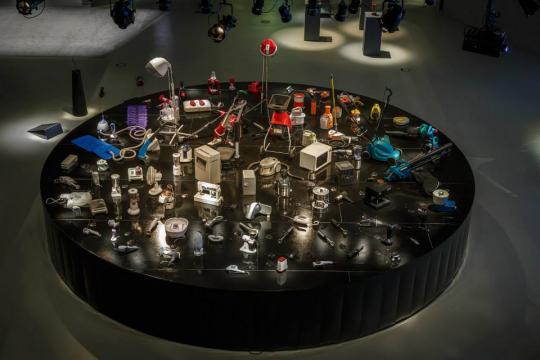»Das Vergerät«
100 Haushaltsgeräte, Holz (lackiert), PVC, Kabel, elektronische Steuergeräte, Mikrofone, Kopfhörer, Monitor, Computer
ø 7 m, H 2,6 m /
100 houshold appliances, wood (painted), pvc, cables, electronic controls, microphones, headphones, monitor, computer
ø 7 m, h 2,6 m
Biennale (DEAF), Dutch Electronic Art Festival »The Progress Trap«, Rotterdam (The Netherlands)
Exhibition 21st of May - 9th of June 2014 at Het Nieuwe Instituut
Festival 21st of May - 24th of May 2014
Production: DEAF, Georg Nagel, Nina Martens (stereomorph.net), Boris Petrovsky
With works of Louis-Philippe Demers, Nam June Paik, Monobanda, Gabriela Golder, Boris Petrovsky, Jenny Holzer, Julie Mecoli, Melle Smets and Joost van Onna, Revital Cohen and Tuur van Balen, Preppers Room, Lucas Foglia, Alicia Framis.
»Das Vergerät« addresses the relationship between humans and machines, technology as social construction and its visual, metaphorical and verbal language. Visitors can initiate communication via software; the message is translated by the interconnected blenders, coffee grinders, espresso machines, vaccuum cleaners, microwaves, drilling machines, electric toothbrushes, shaving machines, hair dryers, drying hoods, vacuum devices, knives, shavers, epilators, knife sharpeners, massage machines, ventilators, fan heaters, high pressure cleaners, floor and car polishers, lawnmowers, leaf blowers, chain saws etcetera and repeated in machine idiom. The strong physical presence of the appliances and their processes triggered by the software lead to the hidden or non-addressed aspects of technology in daily life, which are usually covered up by the fancy, colorful product design of their interface. They transform surroundings and realm domesticities into technotopical spaces. And they become body and speech organ extensions of the 'users'.
»Das Vergerät« (neologism, German) means something like »dis-appliance«. 100 used electric household appliances are interconnected and spatially configurated as a Meta-Machine or Meta-Appliance or as a model of smart homes.
100 is an average number of appliances one can find in a middleclass houshold.
If 'users' put in a spoken message up to 10 seconds into a microphone, the appliances repeat it with their noises, respectively they try to do so. What kind is the understanding between men and machine? Is an understanding possible? The phrases of the 'users' become commands that let the appliances run, controled by the timbre of their voice and the speech melodie of a spoken message and selected by the phonemes. The words of a message and the content become a 'significant' control without a controlable meaning. At the same time the messages will be repeated by a speech synthesis based on the appliances's noises. When they start to run and repeat the users message, it is like that they confirm a command in repeating it. Then the air gets mechanically mixed, cut, grinded, sucked, compressed, blowed, drilled, rolled, stired up, vibrated, heated up and cooled by the appliances while consuming electric power. The human voice is translated in machine's idiom and at the same moment 'incarnated' by the appliances.
100 Haushaltsgeräte, Holz (lackiert), PVC, Kabel, elektronische Steuergeräte, Mikrofone, Kopfhörer, Monitor, Computer
ø 7 m, H 2,6 m /
100 houshold appliances, wood (painted), pvc, cables, electronic controls, microphones, headphones, monitor, computer
ø 7 m, h 2,6 m
Biennale (DEAF), Dutch Electronic Art Festival »The Progress Trap«, Rotterdam (The Netherlands)
Exhibition 21st of May - 9th of June 2014 at Het Nieuwe Instituut
Festival 21st of May - 24th of May 2014
Production: DEAF, Georg Nagel, Nina Martens (stereomorph.net), Boris Petrovsky
With works of Louis-Philippe Demers, Nam June Paik, Monobanda, Gabriela Golder, Boris Petrovsky, Jenny Holzer, Julie Mecoli, Melle Smets and Joost van Onna, Revital Cohen and Tuur van Balen, Preppers Room, Lucas Foglia, Alicia Framis.
»Das Vergerät« addresses the relationship between humans and machines, technology as social construction and its visual, metaphorical and verbal language. Visitors can initiate communication via software; the message is translated by the interconnected blenders, coffee grinders, espresso machines, vaccuum cleaners, microwaves, drilling machines, electric toothbrushes, shaving machines, hair dryers, drying hoods, vacuum devices, knives, shavers, epilators, knife sharpeners, massage machines, ventilators, fan heaters, high pressure cleaners, floor and car polishers, lawnmowers, leaf blowers, chain saws etcetera and repeated in machine idiom. The strong physical presence of the appliances and their processes triggered by the software lead to the hidden or non-addressed aspects of technology in daily life, which are usually covered up by the fancy, colorful product design of their interface. They transform surroundings and realm domesticities into technotopical spaces. And they become body and speech organ extensions of the 'users'.
»Das Vergerät« (neologism, German) means something like »dis-appliance«. 100 used electric household appliances are interconnected and spatially configurated as a Meta-Machine or Meta-Appliance or as a model of smart homes.
100 is an average number of appliances one can find in a middleclass houshold.
If 'users' put in a spoken message up to 10 seconds into a microphone, the appliances repeat it with their noises, respectively they try to do so. What kind is the understanding between men and machine? Is an understanding possible? The phrases of the 'users' become commands that let the appliances run, controled by the timbre of their voice and the speech melodie of a spoken message and selected by the phonemes. The words of a message and the content become a 'significant' control without a controlable meaning. At the same time the messages will be repeated by a speech synthesis based on the appliances's noises. When they start to run and repeat the users message, it is like that they confirm a command in repeating it. Then the air gets mechanically mixed, cut, grinded, sucked, compressed, blowed, drilled, rolled, stired up, vibrated, heated up and cooled by the appliances while consuming electric power. The human voice is translated in machine's idiom and at the same moment 'incarnated' by the appliances.



